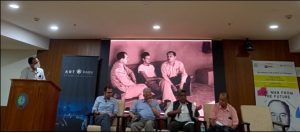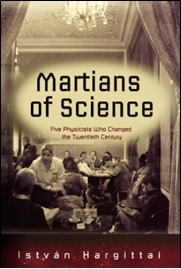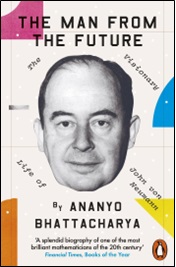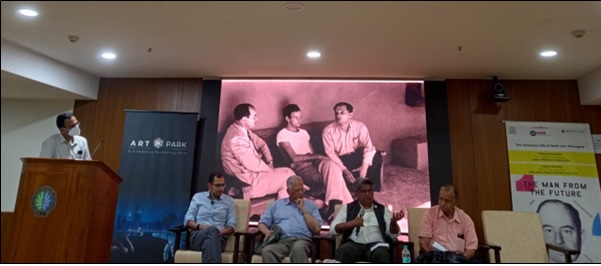
With four parameters I can fit an elephant, and with five I can make him wiggle his trunk.
John von Neumann
The auditorium on the first floor of the Centre for Brain Research (CBR) at the Indian Institute of Science (IISc) was packed on 23 January 2023. It was filled with an audience interested in listening to and interacting with an eminent panel, on the life and works of John von Neumann.
The panellists included Ananyo Bhattacharya, author of The Man from the Future: The Visionary Life of Jon von Neumann, Kalyan Bidhan Sinha, Honorary Professor at the Jawaharlal Nehru Centre for Advanced Scientific Research (JNCASR), Vijay Chandru, Adjunct Professor at the Centre for Biosystems Science & Engineering (BSSE), IISc and Adviser at the AI & Robotics Technology Park (ARTPARK), IISc, and T E S Raghavan, Professor Emeritus at the University of Illinois, Chicago (UIC).
The session was moderated by Rajesh Sundaresan, Dean, Division of Electrical, Electronics, and Computer Sciences (EECS), IISc. K Vijayraghavan, Professor at the National Centre for Biological Sciences (NCBS) and former Principal Scientific Adviser for the Government of India, graced the occasion as the Guest of Honour. The event was organised by ARTPARK and the Kotak IISc AI-ML Centre (KIAC), IISc.
 John von Neumann was one of the ‘Martians’, a term used to refer to five Hungarian scientists who migrated from Europe to the United States after the Great Purge of 1933. István Hargittai’s 2006 book ‘The Martians of Science: Five Physicists Who Changed the Twentieth Century’ talks about these five scientists— Theodore von Kármán, John von Neumann, Leó Szilárd, Edward Teller, and Eugene Wigner—who had a great impact on world events in the twentieth century.
John von Neumann was one of the ‘Martians’, a term used to refer to five Hungarian scientists who migrated from Europe to the United States after the Great Purge of 1933. István Hargittai’s 2006 book ‘The Martians of Science: Five Physicists Who Changed the Twentieth Century’ talks about these five scientists— Theodore von Kármán, John von Neumann, Leó Szilárd, Edward Teller, and Eugene Wigner—who had a great impact on world events in the twentieth century.

The panel discussion on the 23rd revolved around Ananyo Bhattacharya’s book, published in 2023. Speaking about his book, Ananyo explained that the book follows von Neumann’s ideas through time and space to show his influence on our lives today; “Von Neumann is the thread that runs through the book.” In Ananyo’s words, von Neumann “flitted from field to field, implanting seeds”, “he was the big disrupter ever!”, and “he foresaw it all!”
Many aspects of von Neumann’s personality and contributions emerged during the discussion. Different fields including economics, computer science, mathematics, neuroscience, and physics bear the fingerprints of von Neumann, and his work has applications in statistical mechanics, decision theory, and the theory of learning. The profound nature of von Neumann’s work comes through when game theory and the theory of positive operators are studied simultaneously.
He gave the first mathematically rigorous description of quantum mechanics. He proved the minimax theorem and the theory of dynamic equilibrium for two-person zero-sum games in the 1920s. He created a new probability theory that led to operator theory; his operator algebra goes by the name of ‘von Neumann algebra’. Von Neumann also developed the duality theory of linear programming.
Von Neumann crystallised the structure of the modern computer. The first generation of programmable computers was built on his blueprint – the von Neumann architecture machines. He had an astounding ability to translate abstraction to engineering!
He gave the first mathematical proof that machines can reproduce. More recently, stem cell robots have been created – robots that can produce more robots. His deathbed lectures compared the serial computer that he had essentially designed to the brain. His estimates comparing the brain and the computer still hold today. He built a bridge between the brain, neuroscience, and computer science.
His paper on the expanding economy puts forth the idea that all inputs create outputs, and when these are ploughed back into the system with minimum consumption, lead to an equilibrium with balanced growth. The economists of the erstwhile Soviet Union were interested in using this idea!
Neumann used logical formalisms to solve problems, and pursued subjects that had genuine applications for society. Today, the concept of happiness can be traced back to Neumann’s utility theory, which he developed for game theory, wherein human happiness could be put on a scale and compared numerically.
Von Neumann hated totalitarianism. He believed in collaboration, despite being proud of his own work and in spite of academic fights. Compared to other mathematicians of his stature, von Neumann was sociable!
A long queue of audience members waited to get their books ‘The man from the Future: The Visionary Life of John von Neumann’ signed by the author, Ananyo Bhattacharya. “As a science writer, you are always advised to have more knowledge than what you put in a book. But that wasn’t the case here… It stretched me to my absolute intellectual limit!”, says Ananyo.
Among the questions posed to Ananyo, one stands out: “Did von Neumann ever have a moral reckoning on what happened in Japan?” (Von Neumann played a significant role in the development of the atomic bombs which devastated Hiroshima and Nagasaki in 1945.)
Was von Neumann disturbed with the use of the atomic bomb? In one part of Ananyo’s book, there is a description of a nightmarish vision that von Neumann had; his second wife Klara heard him say, “We are creating a monster, and it will make scientists both the most feared and the most wanted people on the planet. It will make us the most despised.” The dark truth is that von Neumann continued to work on the hydrogen bomb well after Hiroshima and Nagasaki.
